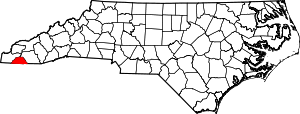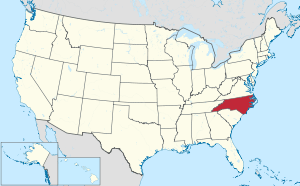Clay County, North Carolina
Clay County is a county located in the far western part of the U.S. state of North Carolina. As of the 2010 census, the county population was 10,587.[1] The county seat is Hayesville, population 311, elevation 1,893 ft.[2]
Clay County | |
|---|---|
.jpg) Clay County Courthouse in Hayesville | |
 Location within the U.S. state of North Carolina | |
 North Carolina's location within the U.S. | |
| Coordinates: 35°04′N 83°46′W | |
| Country | |
| State | |
| Founded | 1861 |
| Named for | Henry Clay |
| Seat | Hayesville |
| Largest town | Hayesville |
| Area | |
| • Total | 221 sq mi (570 km2) |
| • Land | 215 sq mi (560 km2) |
| • Water | 5.9 sq mi (15 km2) 2.7%% |
| Population | |
| • Estimate (2018) | 11,139 |
| • Density | 49/sq mi (19/km2) |
| Time zone | UTC−5 (Eastern) |
| • Summer (DST) | UTC−4 (EDT) |
| Congressional district | 11th |
| Website | www |
History
This area was occupied by the Cherokee Nation at the time of European settlement. The name of Brasstown, an unincorporated community in the county, was derived from a Cherokee term for a village location, which English speakers confused with another that meant "brass." They referred to the village as Brasstown, a translation unrelated to the Cherokee history of the site.
Migrants into the area were primarily of Scots-Irish descent, who had moved into the backcountry of the Appalachians from eastern areas. They moved south from Pennsylvania and Virginia after the American Revolution. Most became yeomen farmers and few owned slaves in the antebellum years.
In the fall of 1860, George Hayes, who was running for state representative from Cherokee County, promised his constituents to introduce legislation to organize a new county in the region. That would bring business associated with a new county seat, and make government accessible to more people. In February 1861 the legislation was introduced and passed by the North Carolina General Assembly.[3] Clay County was formed primarily from Cherokee County, North Carolina, however a small area was taken from Macon County; it was named for statesman Henry Clay, former Secretary of State and member of the United States Senate from Kentucky. In honor of Mr. Hayes, the legislature designated the new county seat as Hayesville.[3]
Given the interruption of the American Civil War, Clay County lacked an organized, formal government until 1868. Later that year, during the Reconstruction era, the first United States post office in the county opened in Hayesville. The first county courthouse was built in 1888; it has been listed on the National Register of Historic Places.[4]
Since the nineteenth century, Clay County has remained largely agricultural.[3] Given its relative isolation, in the 21st century, residents continue to be overwhelmingly of European-American ancestry.
The Clay County Progress is the local newspaper, reporting mostly county news.[5]
Geography
According to the U.S. Census Bureau, the county has a total area of 221 square miles (570 km2), of which 215 square miles (560 km2) is land and 5.9 square miles (15 km2) (2.7%) is water.[6] It is the third-smallest county in North Carolina by land area and smallest by total area.
Clay County is bordered to the south by the state of Georgia and the Chattahoochee National Forest. The Nantahala River forms part of its northeastern border. The county is drained by the Hiwassee River. In the southern part of Clay County is Chatuge Lake, on the North Carolina–Georgia border. Much of Clay County exists within the Nantahala National Forest. Fires Creek Bear Reserve is north of the township of Tusquittee.
The eastern portion of the county is preserved as part of the Nantahala National Forest.
Climate
Clay County has a humid subtropical climate, (Cfa) according to the Köppen classification, with hot, humid summers and mild, but occasionally cold winters by the standards of the southern United States.[7]
Like the rest of the southeastern U.S., Clay County receives abundant rainfall, which is relatively evenly distributed throughout the year. Average annual rainfall is 55.9 inches (1,420 mm). Blizzards are rare but possible; one nicknamed the 1993 Storm of the Century hit the entire Eastern United States in March, 1993.
Demographics
| Historical population | |||
|---|---|---|---|
| Census | Pop. | %± | |
| 1870 | 2,461 | — | |
| 1880 | 3,316 | 34.7% | |
| 1890 | 4,197 | 26.6% | |
| 1900 | 4,532 | 8.0% | |
| 1910 | 3,909 | −13.7% | |
| 1920 | 4,646 | 18.9% | |
| 1930 | 5,434 | 17.0% | |
| 1940 | 6,405 | 17.9% | |
| 1950 | 6,006 | −6.2% | |
| 1960 | 5,526 | −8.0% | |
| 1970 | 5,180 | −6.3% | |
| 1980 | 6,619 | 27.8% | |
| 1990 | 7,155 | 8.1% | |
| 2000 | 8,775 | 22.6% | |
| 2010 | 10,587 | 20.6% | |
| Est. 2018 | 11,139 | [8] | 5.2% |
| U.S. Decennial Census[9] 1790-1960[10] 1900-1990[11] 1990-2000[12] 2010-2013[1] | |||
As of the 2000 United States Census[13] there were 8,775 people, 3,847 households, and 2,727 families residing in the county. The population density was 41 people per square mile (16/km²). There were 5,425 housing units at an average density of 25 per square mile (10/km²). The racial makeup of the county was 98.01% White, 0.80% Black or African American, 0.33% Native American, 0.09% Asian, 0.07% Pacific Islander, 0.15% from other races, and 0.56% from two or more races. 0.83% of the population were Hispanic or Latino of any race.
There were 3,847 households out of which 23.50% had children under the age of 18 living with them, 59.80% were married couples living together, 7.50% had a female householder with no husband present, and 29.10% were non-families. 26.30% of all households were made up of individuals and 14.40% had someone living alone who was 65 years of age or older. The average household size was 2.25 and the average family size was 2.68.
In the county, the population was spread out with 18.60% under the age of 18, 6.20% from 18 to 24, 22.80% from 25 to 44, 29.80% from 45 to 64, and 22.70% who were 65 years of age or older. The median age was 47 years. For every 100 females there were 94.90 males. For every 100 females age 18 and over, there were 91.40 males.
The median income for a household in the county was $31,397, and the median income for a family was $38,264. Males had a median income of $29,677 versus $19,529 for females. The per capita income for the county was $18,221. About 7.80% of families and 11.40% of the population were below the poverty line, including 14.60% of those under age 18 and 13.00% of those age 65 or over.
Communities
Town
- Hayesville (county seat)
Unincorporated communities
- Brasstown
- Elf
- Tusquittee
- Warne
Townships
The county is divided into six townships: Brasstown comprises the westernmost township; Hayesville is centrally located and home to the county seat; Hiawassee, named after the major river in the region, is the smallest township, surrounding Lake Chatuge; Shooting Creek is the easternmost township; Sweetwater is a small township northwest of Hayesville; and Tusquittee is one of the larger townships and the most northern.
Government, politics, and law
Government
The Clay County government is a constitutional body and is granted specific powers by the Constitution of North Carolina, most of which are determined by the state's General Assembly. The county is governed by an elected five member four year term Board of Commissioners.[14]
Politics
In the North Carolina Senate, Clay County is part of the 50th Senate District and is represented by Republican Jim Davis. In the North Carolina House of Representatives, Clay County is part of the 120th District, represented by Republican Kevin Corbin.
As is often true for majority white rural southern counties, Clay County votes primarily Republican. No Democratic Presidential candidate has won Clay County since Jimmy Carter in 1976, and Bill Clinton in 1996 was the last to reach forty percent of the county's vote. Before the Progressive Era, Clay County was uniformly Democratic, but since Charles Evans Hughes became the first Republican to carry the county in 1916, it has voted for the GOP in all but five elections.
Law and public safety
The Clay County sheriff's office is the sole policing agency for the county. The sheriff protects the court and county owned facilities, manages the jail, and provides patrol and detective services.
| Year | Republican | Democratic | Third parties |
|---|---|---|---|
| 2016 | 73.8% 4,437 | 22.8% 1,367 | 3.4% 206 |
| 2012 | 70.4% 3,973 | 28.0% 1,579 | 1.6% 90 |
| 2008 | 66.9% 3,707 | 31.3% 1,734 | 1.8% 102 |
| 2004 | 66.0% 3,209 | 33.5% 1,628 | 0.6% 29 |
| 2000 | 62.7% 2,416 | 35.3% 1,361 | 2.0% 75 |
| 1996 | 48.4% 1,769 | 40.0% 1,462 | 11.6% 424 |
| 1992 | 47.7% 1,890 | 40.4% 1,600 | 11.9% 470 |
| 1988 | 62.5% 2,174 | 37.0% 1,289 | 0.5% 17 |
| 1984 | 62.4% 2,259 | 37.0% 1,340 | 0.6% 20 |
| 1980 | 60.2% 2,136 | 37.3% 1,324 | 2.5% 87 |
| 1976 | 47.4% 1,428 | 52.1% 1,569 | 0.5% 15 |
| 1972 | 65.2% 1,545 | 33.6% 797 | 1.2% 28 |
| 1968 | 54.9% 1,390 | 33.5% 847 | 11.6% 293 |
| 1964 | 46.9% 1,286 | 53.1% 1,457 | |
| 1960 | 56.7% 1,657 | 43.3% 1,264 | |
| 1956 | 52.8% 1,442 | 47.2% 1,287 | |
| 1952 | 50.1% 1,443 | 49.9% 1,439 | |
| 1948 | 47.1% 1,213 | 50.8% 1,307 | 2.1% 55 |
| 1944 | 50.4% 1,263 | 49.6% 1,245 | |
| 1940 | 46.6% 1,176 | 53.4% 1,349 | |
| 1936 | 53.2% 1,525 | 46.8% 1,340 | |
| 1932 | 48.4% 1,265 | 51.3% 1,341 | 0.3% 8 |
| 1928 | 55.1% 1,106 | 45.0% 903 | |
| 1924 | 52.9% 1,090 | 46.2% 953 | 0.9% 18 |
| 1920 | 54.7% 911 | 45.3% 755 | |
| 1916 | 53.1% 453 | 46.9% 400 | |
| 1912 | 2.2% 17 | 47.9% 372 | 49.9% 387 |
References
- "State & County QuickFacts". United States Census Bureau. Archived from the original on July 8, 2011. Retrieved October 18, 2013.
- "Find a County". National Association of Counties. Archived from the original on 2011-05-31. Retrieved 2011-06-07.
- "Welcome to the Clay County Chamber of Commerce". Ncmtnchamber.com. Archived from the original on 2012-08-03. Retrieved 2012-10-27.
- "Hayesville, North Carolina - Home Page". Hayesville.org. Archived from the original on 2012-08-24. Retrieved 2012-10-27.
- Smoky Mountain Sentinel Archived 2013-03-13 at the Wayback Machine, official website; accessed 27 July 2016
- "2010 Census Gazetteer Files". United States Census Bureau. August 22, 2012. Archived from the original on January 12, 2015. Retrieved January 13, 2015.
- "Koppen Climate Classification Chart". Geography.about.com. 2012-04-09. Retrieved 2012-10-27.
- "Population and Housing Unit Estimates". Retrieved July 22, 2019.
- "U.S. Decennial Census". United States Census Bureau. Retrieved January 13, 2015.
- "Historical Census Browser". University of Virginia Library. Retrieved January 13, 2015.
- Forstall, Richard L., ed. (March 27, 1995). "Population of Counties by Decennial Census: 1900 to 1990". United States Census Bureau. Retrieved January 13, 2015.
- "Census 2000 PHC-T-4. Ranking Tables for Counties: 1990 and 2000" (PDF). United States Census Bureau. April 2, 2001. Retrieved January 13, 2015.
- "U.S. Census website". United States Census Bureau. Retrieved 2008-01-31.
- https://www.clayconc.com/
- Leip, David. "Dave Leip's Atlas of U.S. Presidential Elections". uselectionatlas.org. Retrieved 2018-03-15.
External links
| Wikimedia Commons has media related to Clay County, North Carolina. |
- Official website
- Clay County History Wiki
- Smoky Mountain Sentinel, official website of newspaper in Clay County

